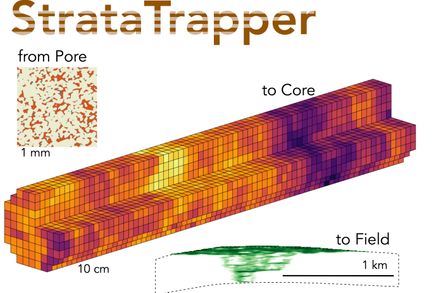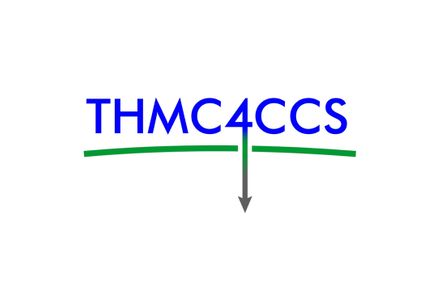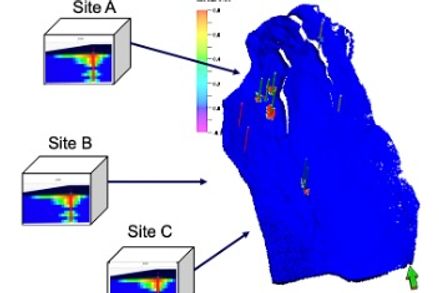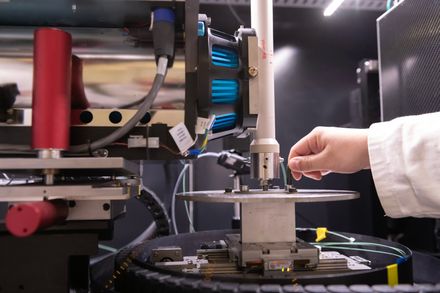We investigate the physics, chemistry, and techno-economics of CO2 storage underground
Our research includes exploring fundamental pore scale fluid dynamics, developing digital rocks analysis techniques, increasing the accuracy of field scale reservoir simulation, and evaluating the feasibility of scaling up CO2 storage to climate relevant scales.
Our Research Projects

StrataTrapper Advanced Modelling of CO2 Migration and Trapping

THMC4CCS: ThorougH experiMental and numerical investigation of Coupled processes for geologiC Carbon Storage
Results
- Showing results for:
- Reset all filters
Search results
-
Journal articleJackson SJ, Lin Q, Krevor S, 2020,
Representative Elementary Volumes, Hysteresis, and Heterogeneity in Multiphase Flow From the Pore to Continuum Scale
, WATER RESOURCES RESEARCH, Vol: 56, ISSN: 0043-1397- Author Web Link
- Cite
- Citations: 35
-
Journal articleKirby ME, Watson JS, Najorka J, et al., 2020,
Experimental study of pH effect on uranium (UVI) particle formation and transport through quartz sand in alkaline 0.1 M sodium chloride solutions
, Colloids and Surfaces A: Physicochemical and Engineering Aspects, Vol: 592, Pages: 1-11, ISSN: 0927-7757A thorough understanding of the aqueous uranium VI (UVI) chemistry in alkaline, sodium containing solutions is imperative to address a wide range of critical challenges in environmental engineering, including nuclear waste management. The aim of the present study was to characterise experimentally in more detail the control of pH on the removal of UVI from aqueous alkaline solutions through particle formation and on subsequent transport through porous media. We conducted first static batch experiments in the pH range between 10.5 and 12.5 containing 10 ppm UVI in 0.1 M NaCl solutions and examined the particles formed using filtration, dynamic light scattering, transition electron microscopy and X-ray powder diffraction. We found that at pH 10.5 and 11.5, between 75 and 96 % of UVI was removed from the solutions as clarkeite and studtite over a period of 48 h, forming particles with hydrodynamic diameters of 640 ± 111 nm and 837 ± 142 nm, respectively and representing aggregates of 10′s nm sized crystals randomly orientated. At pH 12.5, the formation of particles >0.2 μm became insignificant and no UVI was removed from solution. The mobility of UVI in these solutions was further studied using column experiments through quartz sand. We found that at pH 10.5 and 11.5, UVI containing particles were immobilised near the column inlet, likely due physical immobilisation of the particles (particle straining). At pH 12.5, however, UVI quantitatively eluted from the columns in the filter fraction <0.2 μm. The findings of our study reinforce a strong control of solution pH on particle size and U removal in alkaline solutions and subsequently on mobility of U through quartz porous media.
-
Journal articleLiyanage R, Russell A, Crawshaw JP, et al., 2020,
Direct experimental observations of the impact of viscosity contrast on convective mixing in a three-dimensional porous medium
, Physics of Fluids, Vol: 32, Pages: 1-10, ISSN: 1070-6631Analog fluids have been widely used to mimic the convective mixing of carbon dioxide into brine in the study of geological carbon storage. Although these fluid systems had many characteristics of the real system, the viscosity contrast between the resident fluid and the invading front was significantly different and largely overlooked. We used x-ray computed tomography to image convective mixing in a three-dimensional porous medium formed of glass beads and compared two invading fluids that had a viscosity 3.5× and 16× that of the resident fluid. The macroscopic behavior such as the dissolution rate and onset time scaled well with the viscosity contrast. However, with a more viscous invading fluid, fundamentally different plume structures and final mixing state were observed due in large part to greater dispersion.
-
Journal articleGarfi G, John CM, Lin Q, et al., 2020,
Fluid Surface Coverage Showing the Controls of Rock Mineralogy on the Wetting State
, GEOPHYSICAL RESEARCH LETTERS, Vol: 47, ISSN: 0094-8276- Author Web Link
- Cite
- Citations: 25
-
Conference paperRücker M, Bartels W-B, Bultreys T, et al., 2020,
Workflow for upscaling wettability from the nano- to core-scales
, International Symposium of the Society of Core Analysts -
Journal articleRucker M, Bartels W-B, Garfi G, et al., 2020,
Relationship between wetting and capillary pressure in a crude oil/brine/rock system: From nano-scale to core-scale
, Journal of Colloid and Interface Science, Vol: 562, Pages: 159-169, ISSN: 0021-9797HypothesisThe wetting behaviour is a key property of a porous medium that controls hydraulic conductivity in multiphase flow. While many porous materials, such as hydrocarbon reservoir rocks, are initially wetted by the aqueous phase, surface active components within the non-wetting phase can alter the wetting state of the solid. Close to the saturation endpoints wetting phase fluid films of nanometre thickness impact the wetting alteration process. The properties of these films depend on the chemical characteristics of the system. Here we demonstrate that surface texture can be equally important and introduce a novel workflow to characterize the wetting state of a porous medium.ExperimentsWe investigated the formation of fluid films along a rock surface imaged with atomic force microscopy using ζ-potential measurements and a computational model for drainage. The results were compared to spontaneous imbibition test to link sub-pore-scale and core-scale wetting characteristics of the rock.FindingsThe results show a dependency between surface coverage by oil, which controls the wetting alteration, and the macroscopic wetting response. The surface-area coverage is dependent on the capillary pressure applied during primary drainage. Close to the saturation endpoint, where the change in saturation was minor, the oil-solid contact changed more than 80%.
-
Conference paperImanovs E, Krevor S, Zadeh AM, 2020,
CO2-EOR and Storage Potentials in Depleted Reservoirs in the NorwegianContinental Shelf (NCS)
Two global challenges are an increase in carbon dioxide (CO2) concentration in the atmosphere, causingglobal warming and an increase in energy demand (UNFCCC, 2015; EIA, 2018). Carbon Capture andStorage (CCS) is believed to be a major technology to considerably reduce CO2 emissions (Budinis et al.,2018). Applying this technology, the anthropogenic CO2 could be injected into depleted reservoirs andpermanently stored in the subsurface. However, standalone CCS projects may not be economically feasibledue to CO2 separation, transportation and storage costs (Pires et al., 2011). On the other hand, one of themost efficient Enhanced Oil Recovery (EOR) methods is carbon dioxide injection (Holm, 1959). Therefore,a combination of CO2-EOR and storage schemes could offer an opportunity to produce additional oil fromdepleted reservoirs and permanently store CO2 in the subsurface in an economically efficient manner. In this study, a depleted sandstone reservoir located in the Norwegian Continental Shelf (NCS) is used. Aninnovative development scenario is considered, involving two phases: CO2 storage phase at the beginningof the project followed by a CO2-EOR phase. The objective of this paper is to evaluate the effect of differentinjection methods, including continuous gas injection (CGI), continuous water injection (CWI), WaterAlternating Gas (WAG), Tapered WAG (TWAG), Simultaneous Water Above Gas Co-injection (SWGCO),Simultaneous Water and Gas Injection (SWGI) and cyclic SWGI on oil recovery and CO2 storage potentialin the depleted reservoir. A conceptual 2D high-resolution heterogeneous model with one pair injector-producer is used toinvestigate the mechanisms taking place in the reservoir during different injection methods. This knowledgeis applied in a field scale, realistic 3D compositional reservoir model of a depleted sandstone reservoir inthe NCS including ten oil producers and twenty water/gas injectors. The simulation results demonstrate that innovative development scen
-
Book chapterKrevor S, Blunt MJ, Trusler JPM, et al., 2020,
Chapter 8: An introduction to subsurface CO<inf>2</inf> storage
, RSC Energy and Environment Series, Pages: 238-295The costs of carbon capture and storage are driven by the capture of CO2 from exhaust streams or the atmosphere. However, its role in climate change mitigation is underpinned by the potential of the vast capacity for storage in subsurface geologic formations. This storage potential is confined to sedimentary rocks, which have substantial porosity and high permeability in comparison to crystalline igneous and metamorphic rocks. These in turn occur in the sedimentary basins of the Earth's continents and near shore. However, the specific capacity for storage is not correlated simply to the existence of a basin. Consideration must also be made of reservoir permeability, caprock integrity, injectivity, fluid dynamics, and geomechanical properties of pressurisation and faulting. These are the topics addressed in this chapter. These processes and properties will combine in complex ways in a wide range of settings to govern the practicality of storing large volumes of CO2. There is clear potential for storage at the scale required to mitigate the worst impacts of global climate change, estimated to be in the order of 10 Gt CO2 per year by 2050. However, until at least dozens of commercial projects have been built in a range of geologic environments, the upper reaches of what can be achieved, and how quickly, will remain uncertain.
-
Conference paperImanovs E, Krevor S, Zadeh AM, 2020,
CO<inf>2</inf>-EOR and storage potentials in depleted reservoirs in the norwegian continental shelf NCS
Two global challenges are an increase in carbon dioxide (CO2) concentration in the atmosphere, causing global warming and an increase in energy demand (UNFCCC, 2015; EIA, 2018). Carbon Capture and Storage (CCS) is believed to be a major technology to considerably reduce CO2 emissions (Budinis et al., 2018). Applying this technology, the anthropogenic CO2 could be injected into depleted reservoirs and permanently stored in the subsurface. However, standalone CCS projects may not be economically feasible due to CO2 separation, transportation and storage costs (Pires et al., 2011). On the other hand, one of the most efficient Enhanced Oil Recovery (EOR) methods is carbon dioxide injection (Holm, 1959). Therefore, a combination of CO2-EOR and storage schemes could offer an opportunity to produce additional oil from depleted reservoirs and permanently store CO2 in the subsurface in an economically efficient manner. In this study, a depleted sandstone reservoir located in the Norwegian Continental Shelf (NCS) is used. An innovative development scenario is considered, involving two phases: CO2 storage phase at the beginning of the project followed by a CO2-EOR phase. The objective of this paper is to evaluate the effect of different injection methods, including continuous gas injection (CGI), continuous water injection (CWI), Water Alternating Gas (WAG), Tapered WAG (TWAG), Simultaneous Water Above Gas Co-injection (SWGCO), Simultaneous Water and Gas Injection (SWGI) and cyclic SWGI on oil recovery and CO2 storage potential in the depleted reservoir. A conceptual 2D high-resolution heterogeneous model with one pair injector-producer is used to investigate the mechanisms taking place in the reservoir during different injection methods. This knowledge is applied in a field scale, realistic 3D compositional reservoir model of a depleted sandstone reservoir in the NCS including ten oil producers and twenty water/gas injectors. The simulation results demonstrate that innovative
-
Journal articleNiu B, Krevor S, 2020,
The Impact of Mineral Dissolution on Drainage Relative Permeability and Residual Trapping in Two Carbonate Rocks
, TRANSPORT IN POROUS MEDIA, Vol: 131, Pages: 363-380, ISSN: 0169-3913- Author Web Link
- Cite
- Citations: 5
This data is extracted from the Web of Science and reproduced under a licence from Thomson Reuters. You may not copy or re-distribute this data in whole or in part without the written consent of the Science business of Thomson Reuters.



